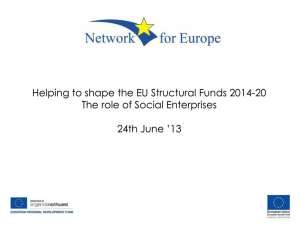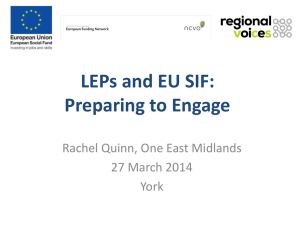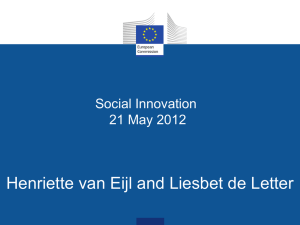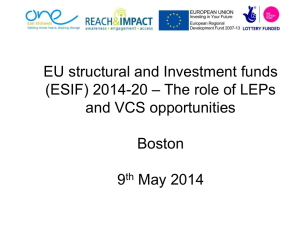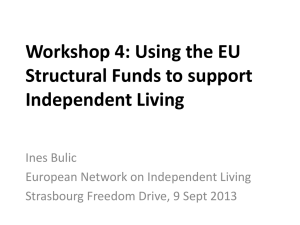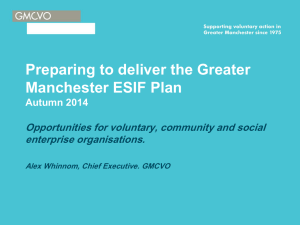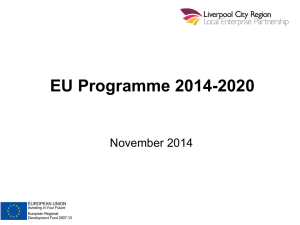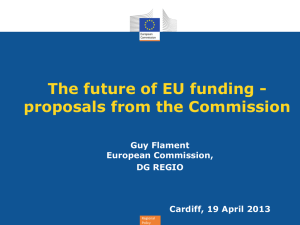The Latest News on European Funding
advertisement
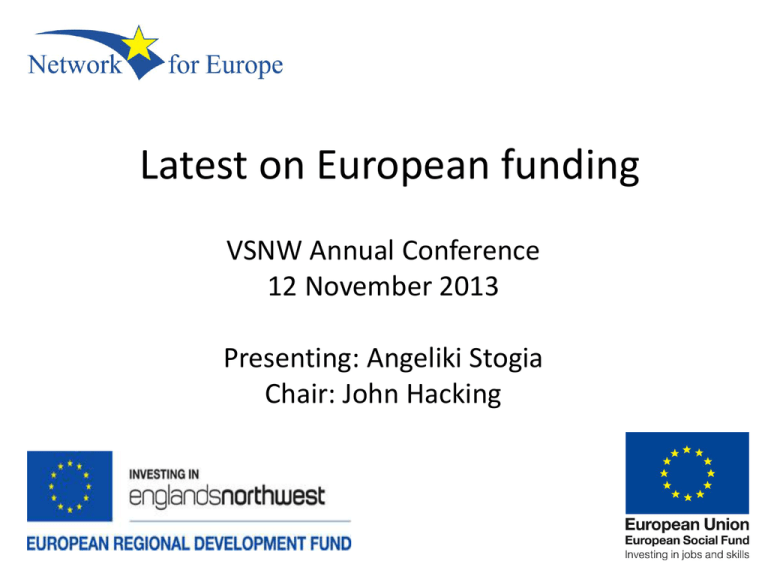
Latest on European funding VSNW Annual Conference 12 November 2013 Presenting: Angeliki Stogia Chair: John Hacking Workshop aims • European Structural funds in the North West • 2007-2013 current opportunities to access • An overview of emerging priorities for EU funds in the new programme • Discussion: – Reflecting on priorities and areas where VCS can be involved – Delivering the new programmes in the future: your role in the programmes – What type of support do you need? European Regional Development Fund (ERDF) ERDF supports regional development though actions such as business innovation and support and regeneration. It finances investment to create sustainable jobs, infrastructure linked to research and innovation, environment, communications, energy and transport and financial instruments (capital risk funds, local development funds) that support regional and local development •Priority 1: Stimulating Enterprise and Supporting growth in target sectors and markets •Priority 2: Exploiting innovation and knowledge •Priority 3: Creating the conditions for sustainable growth •Priority 4: Growing and accessing employment Accessing ERDF Through the department of Communities and Local Government • Minimum ERDF levels of funding • Projects are subject to a two stage application process: – Stage 1: Outline Application - deliverability test and outline assessment – Stage 2: Full application - detailed technical appraisal • LEP endorsement is required • All money committed* European Social Fund ESF aims to improve employment opportunities in the European Union by providing financial support towards the running costs of vocational training schemes, guidance and counselling projects, job creation measures and other steps to improve the employability and skills of both employed and unemployed people • Priority 1: Extending Employment Opportunities: to increase employment and to reduce unemployment and inactivity • Priority 2: Developing a Skilled and Adaptable Workforce: reducing the number of people without basic skills, developing managers and workers in small enterprises Accessing ESF ESF is accessed through Co-financing organisations • Co-financing means channelling ESF and the required match funding to providers in a single stream • Organisations which do this are called Co-financing organisations Accessing ESF in the North West There are three Co-financing organisation in the North West: • Skills Funding Agency aims to improve the employability and skills of employed and unemployed people by supporting education and vocational training schemes and learning **awaiting information on mop-up rounds** • Jobcentre Plus/DWP supports disadvantaged people claiming incapacity benefit or Income Support through voluntary participation in the work programme and provides targeted support to tackle workessness in families with multiple problems • National Offender Management Service (NOMS) aims to enhance the employability prospects of offenders by bridging the existing gaps between offenders and mainstream education, skills and employment services before, during and after release from custody European Social Fund: Small Grants Community Grants - Helping people access the labour market • Supporting a range of activities aim at assisting the disadvantaged or excluded to move closer to the labour market, focusing on individuals who have difficulty accessing ESF or mainstream provision outcomes • Based on progression, activities include first contact engagement, confidence building, help with basic skills, taster work experience, training, advice, counselling, jobsearch • Grants up to £12K* accessed through simplified application arrangements, available to voluntary sector groups. Grants accessed through Community Grants Coordinating Bodies • *Awaiting results of recent tendering process – rounds for projects starting in the new year limit increased to £15K* European Funding ESF & ERDF • Current Programme 2007-13 – ESF National – ERDF regional • Next Programme 2014-20 – Single English Pot (hides the wiring) – Maximum devolution to LEP level • but LEPs can link to each other – Key Themes 2014 – 2020 Decision levels • European Commission – Regulations – Finance – Partnership Principles • Member State – Partnership – Operational Programmes • Local Partners – Working together – Delivering change The draft Regulations • • • • • General Regulations ESF ERDF Cohesion Fund European Grouping for Territorial Cohesion • Economic • Social • and Territorial • Cohesion Europe 2020 • Smart • Sustainable • Inclusive 15 Eleven Themes • • • • • • • • • • • Innovation ICT SME competitiveness Low Carbon Climate Change Environment and Resource Efficiency Sustainable Transport Employment Social Inclusion Skills (Institutional Capacity) ERDF minimum allocations At least 60% (transition) or 80% (More Developed) on: • Innovation • ICT • SME • Low Carbon At least 15% (transition) or 20% (more developed) on: • Low Carbon European Social Fund • • • • • Minimum 40% in transition regions, 52% in developed Minimum 20% for social inclusion Greater emphasis on Youth Unemployment Better involvement of social partners, local authorities, NGOs Simplification, improve accessibility of funding especially for small beneficiaries • More lump sums & standard costs, lighter admin 19 BIS Guidance to LEPs July • Supplementary Guidance – Annexes • Match • Opt In • Financial Instruments • Community Led Local Development • Social Innovation • Background Analysis – Ten Themes • Opt In Prospectuses – 6 Organisations [2 added later, perhaps more...] Opt - in “opt-in model” developed to allow LEPs and partners to join with national organisations/ programmes to deliver key priorities. By opting-in to a service offer from a national organisation/ programme, a LEP commits part of it ESI Funds allocation to the programme More “opt-in” offers Second wave of opt-in offers include: • DWP/JCP – Promoting employment and supporting labour mobility, also covers Social Inclusion and Combating Poverty • Prince’s Trust – ICT, SME Competitiveness; Low Carbon; Promoting Employment; Promoting Social Inclusion; Education & Skills • Arts Council What is Community Led Local Development (CLLD)? • • • • • • Modelled on previous Leader approaches (RDPE) An optional tool for territorial development Focussed on sub-regional areas (10-150,000 population) Driven by local communities Multi-sectoral (public, private and civil society) Integrated approach single or multi-fund options possible e.g. ESF + ERDF; Leader + ESF + ERDF; EMFF + ESF etc. What is CLLD? • CLLD will be focused on the specific needs and opportunities of a particular area, usually much smaller than the average Local Enterprise Partnership, and typically through small local community projects. • CLLD could be related to a particular theme, such as urban mobility, local energy plans or labour market issues, or to a particular target group, such as young people or migrants. It can be used across urban, rural and coastal areas. • CLLD is a model that would be particularly useful in situations where there are specific small geographic areas with high levels of need that require a more targeted approach. It would combine well with other local community-led interventions. What is Social Innovation? • The development and implementation of new ideas (products, services and models) to meet social needs and create new social relationships or collaborations. It represents new responses to pressing social demands, which affect the process of social interactions. It is aimed at improving human well-being • Social innovations are innovations that are social in both their ends and their means. They are innovations that are not only good for society but also enhance individuals’ capacity to act What is Social Innovation? • Social innovation is the process of finding and implementing new ways to tackle major problems that affect society as a whole or specific groups • Draws on the determination and knowledge of local communities, of ‘not-for-profits’, or of social entrepreneurs, alongside businesses, individuals and researchers • Seeks to deliver better social outcomes by drawing on their collective resources of time, skills, networks and relationships, often using new technologies, to build scale and spread change England timetable so far • BIS (Business, Innovation and Skills) leading – Then DWP (ESF) and DCLG (ERDF) • 3.5 people seconded (1 HE, 1.5 LA, 1 VCS) – Sandra Turner, NCVO, SImon Nokes p/t Manchester • BIS Roadshows November and December 2012 • BIS Letter to LEPs 7th Feb 13 • BIS Initial Guidance to LEPs 17th April • Indicative Allocation to LEPS 27 June • BIS Supplementary Guidance to LEPs 19 July • Deadline for LEP Strategies 7 Oct England timetable next steps • 7 Oct deadline for LEPs draft Strategies • 8-16 Oct BIS analyses strategies – Themes, Eligibility, Outputs and Results, Mng Agent, Local • 6 Nov Shadow Growth Board Meets, endorses responses • 7 Nov - local growth team feeds back to each LEP • Nov-Dec LEPs revise and refine proposals • Jan ‘14 - Final LEP Strategies to BIS • UK Government submit England proposals to European Commission • Negotiations with Commission, revisions to LEP plans • Programmes start – later in 2014 (autumn?) Cheshire and Warrington Cheshire and Warrington: Four Priorities Cumbria: Four Priorities • • • • Maximising Growth in the Specialist Manufacturing Sector Maximising Opportunities from Nuclear and Energy Niche High Value Added Tourism & the visitor Economy Developing the Value of and Growth in the Food &Drink Sector (LEP proposes making use of all ten EU thematic priorities in support of our growth proposals) Greater Manchester: Six Strands • • • • • • Competitive Places Science, Innovation and Knowledge Economy Competitive Business Low Carbon Skills, Employment and Inclusion Supporting Reform Lancashire: Six Strands • Investing in Strategic Infrastructure, Development and Environmental Resilience • Boosting Business Growth and Innovation • Promoting Growth sectors and Supply Chains • Encouraging Inward Investment and Marketing • Driving the Skills for Growth • Creating Opportunities for Disadvantaged Communities/Groups Liverpool City Region: Five Portofolios • • • • • Blue/Green Economy Business Economy Innovation Economy Inclusive Economy Place & Connectivity Social Inclusion The Europe 2020 strategy has a target of promoting social inclusion, in particular through the reduction of poverty, by aiming to lift at least 20 million people out of the risk of poverty and social exclusion • • • • • Cheshire and Warrington £11m Cumbria £7.5m Greater Manchester £46m Lancashire £18m Liverpool City Region £20m Next Steps • Response from BIS after 6th November • Consultations in November and December • Work up the details – Good practice – Volumes, costings and detailed working – Opt Ins negotiation, local control, and match – Governance Glimpse into the future: DWP/JCP • • • • • Community Work Placements – part of the Help to Work support. Designed for JSA and Universal Credit (full conditionality) claimants who have completed the Work Programme and whose key barrier preventing them from moving into work, is either insufficient recent work history or a lack of motivation Launched 24 October, tenders due back on 5 Dec 2013 Part-funded by the European Social Fund, under DWP’s cofinancing agreements Preferred Bidders announced on 3 March 2014 Going live starting from April 2014 Open to Employment Related Support Services (ERSS) Framework providers Key Messages • Smart – Sustainable – Inclusive • ESF, ERDF, EAFRD, EMFF working together • Simplification – focus on outputs and results – Flat Rates, Lump Sums, Proportionality – Opt-ins • Place-based solutions, transition areas, city regions – Community Led Local Development – Joint actions – result based approach – Social Innovation What do you think? • Feedback session: – Reflecting on priorities and areas where VCS can be involved – Delivering the new programmes in the future: your role in the programmes – What type of support do you need? Eleven Themes • • • • • • • • • • • Innovation ICT SME competitiveness Low Carbon Climate Change Environment and Resource Efficiency Sustainable Transport Employment Social Inclusion Skills (Admin Capacity) European Structural Investment Fund 2014-20 High Level Business Process Local Enterprise Partnership Investment Plan Project Implementation Routes into the Programme Opt-In Negotiated procedure with Opt-In organisations Open Call Seeks ideas to deliver against strategy LEP Defined Activity Commissioned investments / direct bids etc. Assess Strategic Fit Monitor Performance against Strategy Confirm strategic fit Instruction to Invest Applicant Develop Full Application Write Initial Application Managing Authority Selection into the Programme Funding Agreement Facilitation to complete full Application Form Funding Agreement Technical Appraisal Project Delivery Project Close Contract Management& Monitoring Closure Reporting – All data on IT system – Reports drawn off as required Annex to Paper to the Growth Programme Board 151 Dale Street, Liverpool, L2 2AH Tel: 0151 237 3972 Fax: 0151 237 3973 Email: info@networkforeurope.eu Website: www.networkforeurope.eu Facebook: www.facebook.com/networkforeurope Twitter: @network4europe
